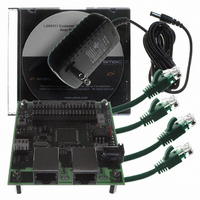EVB9311 SMSC, EVB9311 Datasheet - Page 96

EVB9311
Manufacturer Part Number
EVB9311
Description
EVALUATION BOARD LAN9311-NU
Manufacturer
SMSC
Series
0133r
Datasheet
1.LAN9311-NU.pdf
(460 pages)
Specifications of EVB9311
Main Purpose
Interface, Ethernet
Embedded
No
Utilized Ic / Part
LAN9311
Primary Attributes
2 Ports, 100BASE-TX/10BASE-T, Managed
Secondary Attributes
2 PHYs with HP Auto-MDIX, Auto- Flow Control, 32-bit CRC, MDI/MDI-X
Lead Free Status / RoHS Status
Lead free / RoHS Compliant
Other names
638-1076
- Current page: 96 of 460
- Download datasheet (5Mb)
Revision 1.7 (06-29-10)
7.2.10.2
7.2.10.3
7.2.11
7.2.12
7.3
7.3.1
PHY Software Reset via PHY_BASIC_CTRL_x
The PHY can also be reset by setting bit 15 (PHY_RST) of the
(PHY_BASIC_CONTROL_x). This bit is self clearing and will return to 0 after the reset is complete.
This reset does not reload the configuration strap values into the PHY registers.
PHY Power-Down Reset
After the PHY has returned from a power-down state, a reset of the PHY is automatically generated.
The PHY power-down modes do not reload or reset the PHY registers. Refer to
Power-Down Modes," on page 94
LEDs
Each PHY provides LED indication signals to the GPIO/LED block of the LAN9311/LAN9311i. This
allows external LEDs to be used to indicate various PHY related functions such as TX/RX activity,
speed, duplex, or link status. Refer to
information on the configuration of these signals.
Required Ethernet Magnetics
The magnetics selected for use with the LAN9311/LAN9311i should be an Auto-MDIX style magnetic,
which is widely available from several vendors. Please review the SMSC Application note 8.13
“Suggested Magnetics” for the latest qualified and suggested magnetics. A list of vendors and part
numbers are provided within the application note.
The Virtual PHY provides a basic MII management interface (MDIO) to the Host MAC per the IEEE
802.3 (clause 22) so that an unmodified driver can be supported as if the Host MAC was attached to
a single port PHY. This functionality is designed to allow easy and quick integration of the
LAN9311/LAN9311i into designs with minimal driver modifications. The Virtual PHY provides a full bank
of registers which comply with the IEEE 802.3 specification. This enables the Virtual PHY to provide
various status and control bits similar to those provided by a real PHY. These include the output of
speed selection, duplex, loopback, isolate, collision test, and auto-negotiation status. For a list of all
Virtual PHY registers and related bit descriptions, refer to
page
Virtual PHY Auto-Negotiation
The purpose of the auto-negotiation function is to automatically configure the Virtual PHY to the
optimum link parameters based on the capabilities of its link partner. Because the Virtual PHY has no
actual link partner, the auto-negotiation process is emulated with deterministic results.
Auto-negotiation is enabled by setting bit 12 (VPHY_AN) of the
(VPHY_BASIC_CTRL)
Virtual PHY
Power-On Reset (POR)
Hardware reset (nRST)
PHY Software reset (via bit 3 of the
Management Control Register
(VPHY_BASIC_CTRL))
Setting the
Digital Reset (via bit 10 of the
Issuing an EEPROM Loader RELOAD command
287.
Virtual PHY Basic Control Register
and is restarted by the occurrence of any of the following events:
(PMT_CTRL), or bit 15 of the
Reset Control Register
for additional information.
DATASHEET
Chapter 13, "GPIO/LED Controller," on page 163
Reset Control Register
96
Two Port 10/100 Managed Ethernet Switch with 16-Bit Non-PCI CPU Interface
(VPHY_BASIC_CTRL), bit 9 high (auto-neg restart)
(Section 10.2.4, "EEPROM Loader," on page
(RESET_CTL))
Section 14.4.1, "Virtual PHY Registers," on
(RESET_CTL), bit 0 of the
Virtual PHY Basic Control Register
Virtual PHY Basic Control Register
Port x PHY Basic Control Register
SMSC LAN9311/LAN9311i
Section 7.2.9, "PHY
for additional
Power
Datasheet
150)
Related parts for EVB9311
Image
Part Number
Description
Manufacturer
Datasheet
Request
R

Part Number:
Description:
FAST ETHERNET PHYSICAL LAYER DEVICE
Manufacturer:
SMSC Corporation
Datasheet:

Part Number:
Description:
357-036-542-201 CARDEDGE 36POS DL .156 BLK LOPRO
Manufacturer:
SMSC Corporation
Datasheet:

Part Number:
Description:
357-036-542-201 CARDEDGE 36POS DL .156 BLK LOPRO
Manufacturer:
SMSC Corporation
Datasheet:

Part Number:
Description:
357-036-542-201 CARDEDGE 36POS DL .156 BLK LOPRO
Manufacturer:
SMSC Corporation
Datasheet:

Part Number:
Description:
4-PORT USB2.0 HUB CONTROLLER
Manufacturer:
SMSC Corporation
Datasheet:

Part Number:
Description:
Manufacturer:
SMSC Corporation
Datasheet:

Part Number:
Description:
Manufacturer:
SMSC Corporation
Datasheet:

Part Number:
Description:
FDC37C672ENHANCED SUPER I/O CONTROLLER WITH FAST IR
Manufacturer:
SMSC Corporation
Datasheet:

Part Number:
Description:
COM90C66LJPARCNET Controller/Transceiver with AT Interface and On-Chip RAM
Manufacturer:
SMSC Corporation
Datasheet:

Part Number:
Description:
Manufacturer:
SMSC Corporation
Datasheet:

Part Number:
Description:
Manufacturer:
SMSC Corporation
Datasheet:

Part Number:
Description:
Manufacturer:
SMSC Corporation
Datasheet:

Part Number:
Description:
Manufacturer:
SMSC Corporation
Datasheet:











